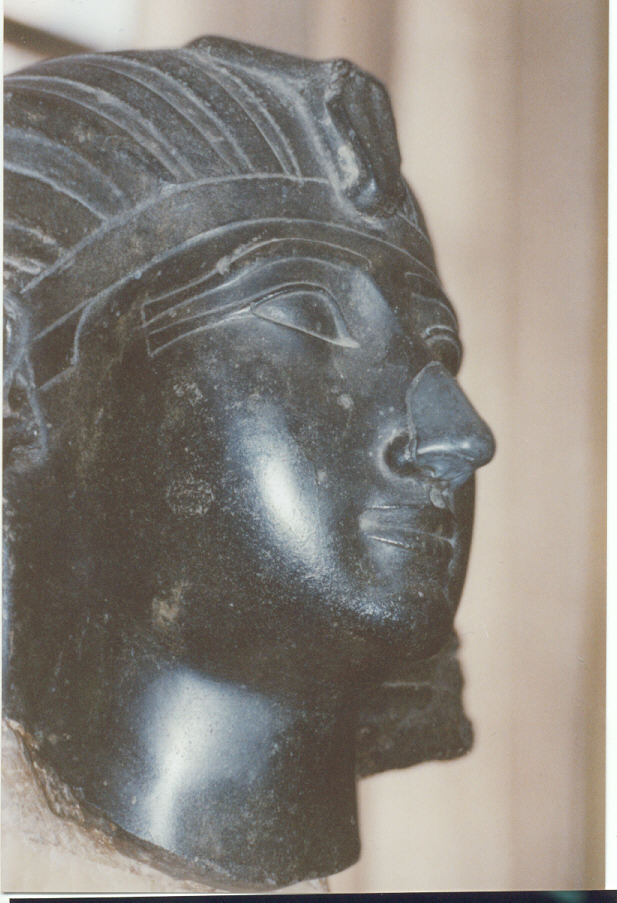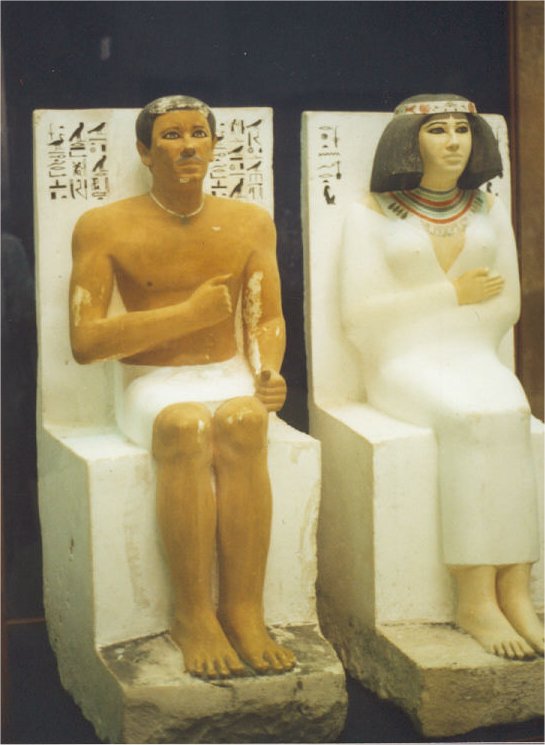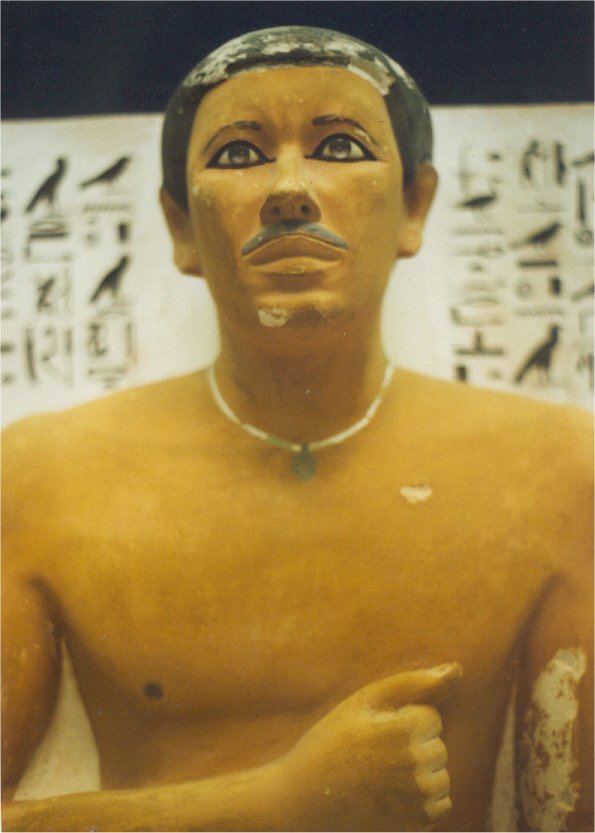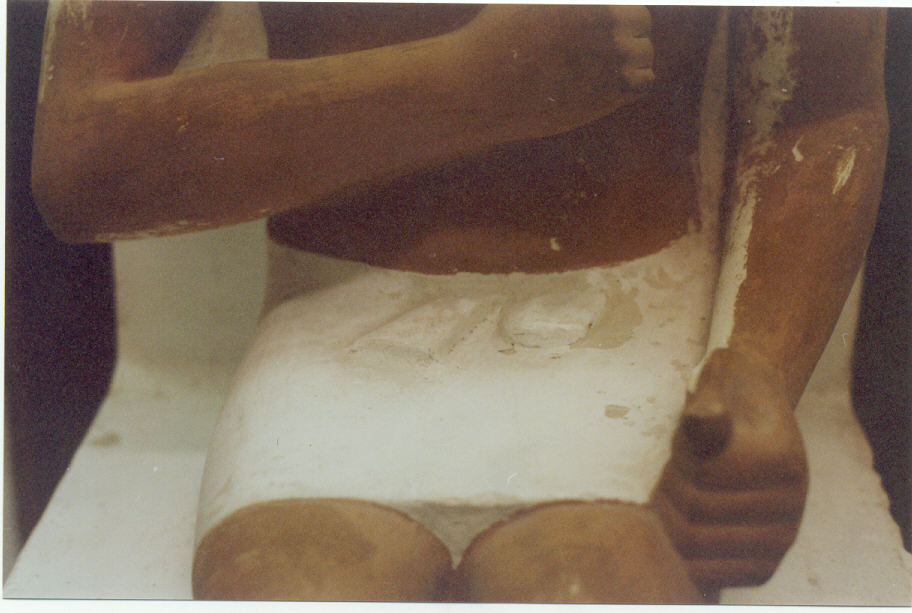| Trinicenter | RootsWomen | RaceandHistory | HowComYouCom |
Groundbreaking New Book: MODERN FRAUD CLASSICAL AFRICAN CIVILIZATIONS Part III: The Museum Evidence Prof. Manu Ampim In parts I and II of The Vanishing Evidence series, I examined the progressive decay and deliberate acts of destruction to temple and tomb carvings. An additional aspect of this problem is the systematic altering of images in museums throughout Egypt and the Western World. The vast majority of statues, paintings, and relief images have been subtlety, and in many cases drastically, altered by conspirators to give them a non-African appearance. The changing of the racial identity of the vast majority of the ancient Egyptian images in museums is a major international issue which has been unaddressed. Through my primary research at nearly all of the major museums throughout Europe, America, Canada, and Egypt, I have been able to observe that there is an effective and systematic effort to destroy or eliminate the statues and paintings, which demonstrate that the founders and builders of ancient Egypt were Black people. FACIAL & RACIAL RECONSTRUCTION Museum artifacts are often manipulated and altered by a number of groups having access to these materials before they are viewed by the public. The broad group of conspirators involved with this cunning behind-the-scenes work includes: archeologists, Egyptologists, and government workers, who dig up, record, and decide the fate of the artifacts; restoration and conservation workers, who restore and piece the broken artifacts back together; and museum workers and officials who are the last group to handle the artifacts before they go on public display. The archaeologists/excavators and Egyptologists who dig up the artifacts have exclusive access to them until they are transported and turned over to a museum or other institution.
 Officials of an Italian museum decided to give Thutmosis III a new nose in a crude and outrageous attempt to change his racial appearance. However, many private collections have been organized around the numerous artifacts that are never reported or recorded and are consequently stolen, and then sold or smuggled out of the country by members of the excavation team. Local Arab villagers not associated with an archaeological team are also heavily involved in tomb robbing and reshaping artifact images, before they are eventually found in a private collection or public museum. Museum artifacts are therefore handled, repaired, worked on, and “restored” behind the scenes before they are put on public display. Thus, the time from the initial excavation of an artifact until it is displayed for public viewing can be several years. In this time period, incredible changes are usually made to the statues, paintings, and reliefs. In fact, a careful examination of the ancient Egyptian artifacts bearing racial images in any museum or collection will demonstrate that the vast majority of items have been re-worked to change or obscure the racial identity. These museum images have been tampered with and often thoroughly de-Africanized, as they have been transformed from African to a European or some type of mixed group.
 The Ra-Hotep and Nofret statues are seated in strange chairs with backboards and Mdw Ntr writing near their head. These statues are among the greatest forgeries in the history of ancient African archaeology. [Manu Ampim, Modern Fraud: The Forged Ancient Egyptian Statues of Ra-Hotep and Nofret (forthcoming)] The reconstruction methods of the conspirators range from crude to sophisticated, and each process has the intent of changing the African racial identity of the images. For example, paint colors are systematically lightened or completely erased; noses are broken off or sanded down on the sides to make then thinner; the length of the lips are shortened to make them appear smaller; chins are knocked off to distort the facial structure; and other images are completely fabricated.
 The Ra-Hotep statue violates a long list of clearly defined rules. A few of these rules are: Ra-Hotep is a royal son and high ranking official, but he does not wear a wig; he has a gray moustache; and he never had an emblem in his right hand across his chest.  Ra-Hotep's entire kilt belt is shown on his lap, rather than the universal ancient Egyptian practice of showing one belt-end protruding from the waist line. Also, Ra-Hotep never had an emblem in his left hand. Museums around the world are filled with artifacts that have been thoroughly altered and de-Africanized by the conspirators. The following is a short list of these museums: ¨ The Rosicrucian Egyptian Museum in San Jose, California claims to have “the largest collection of Egyptian artifacts on exhibit in the western United States,” but much of its collection is actually made up of replicas and reconstructions, with images predictably resembling modern Europeans features. ¨ The Metropolitan Museum in New York, among other problems, has an entire room dedicated to Queen Hapshepsut, and every image of her has undergone obvious nose reconstruction. ¨ The National Museum of Antiquities in Holland has a number of statues that have undergone careful facial reconstruction. ¨ The Cairo Museum in Egypt contains forgeries and dozens of statues with nose alterations, and lightened colors which now resemble the pale skin tone of Europeans. ¨ The Boston Museum of Fine Arts amazingly has “replacement heads” in the middle of the museum floor, while the more important statues of Black rulers and officials are off to the side of the room, or in the basement, safely away from the view of tourists. ¨ The Louvre Museum in France has some of the most stunning and powerful African images of important figures anywhere in the world, yet the museum has bold signs placed in strategic locations throughout the Egyptian gallery, directing tourists to one particular statue: the “unnamed seated scribe,” who has undergone a thorough racial makeover and now appears European. ¨ The British Museum in England has re-worked the faces of statues so well that it in a few cases it is extremely difficult to detect their work. ¨ The Art History Museum in Austria is organized totally backward, as the foreign period of the Greeks, Romans and other invaders is placed in the front portion of the Egyptian gallery, so that this is the first impression that tourists get. Meanwhile, the real builders of Kemetian civilization are placed strategically in the back of the gallery. ¨ The Manchester Museum in Britain uses skull remains to do facial reconstructions, which almost always resembles Europeans, or else they have no particular ethnic identity. These and many other museums around the world are collectively eliminating
the Black identity of the ancient Egyptian and Nubian civilizations
through carefully thought out and misleading displays and gallery arrangements.
The obvious goal of these institutions is to destroy the memory of an Black
ancient Egypt and Nubia. Unfortunately, they have been quite successful
in this long range project, as each month millions of tourists visit these
museums and get a totally false impression of the identity of the ancient
Egyptians and Nubians.
ORIENTATION AND DISTORTION In addition to the facial and racial makeovers that have been performed
on the vast majority of artifacts, the museum gallery organization and
layout is another effective method of distortion. The Art History
Museum in Austria is one of many museums that use gallery layout and orientation
strategies to deceive the public by confusing the racial identity of the
indigenous people of ancient Egypt. For example, along with placing
the Greek and Roman statues in prominent locations, museums also disregard
dates and time periods, and instead lump artifacts together in general
categories (such as statues, pottery, papyri, coffins, mummies, etc.),
eventhough
these artifacts may have been made several thousand years apart.
Thus, one finds African statues from the early pyramid age next to those
from the foreign period of Greek and Roman rulers at the very end of ancient
Egyptian civilization 2,500 years later!
MODERN FORGERIES A large number of Egyptian forgeries have been discovered over the years, and perhaps the greatest of them all are the statues of prince Ra-Hotep and his wife Nofret. These two statues in room 32 of the Cairo Museum are among the most famous “ancient Egyptian” statues, as they have been featured and written about in a long list of publications. Their popularity is also due to the fact that they are totally unique and they look European. Elsewhere in a preliminary essay, “Ra-Hotep and Nofret: Modern Forgeries in the Cairo Museum?” I have outlined 21 major problems with these unique statues that put them in direct contradiction to the strict artistic rules by which all Kemetian royal sculptors were bound. In the future, I will be publishing my full research exposing these forgeries in a forthcoming book entitled, Modern Fraud: The Forged Ancient Egyptian Statues of Ra-Hotep and Nofret.1 While ancient African culture and history continues to vanish, the African American community is doing little to stop this process. The African African community could be in the forefront of protecting and preserving the records and remains of classical African civilizations, but on this issue it lacks direction and leadership. If the current rate of destruction, distortion, and theft of temple, tomb, and museum evidence continues, then little primary evidence will remain by the end of this century, and thus the falsification of classical African culture and history will be easier and more effective. Anyone interested in joining the national campaign to stop the vanishing evidence of classical African civilizations, should refer to the recommendations in part I of The Vanishing Evidence series.
[1] See Manu
Ampim, “Ra-Hotep and Nofret: Modern Forgeries in the Cairo Museum?”
pp. 207-212 in Egypt:
Child of Africa (1994), edited by Ivan Van Sertima.
Prof. Manu Ampim is a historian and primary researcher on African and African American culture & history. He is director of Advancing The Research and can be reached at PO Box 18623, Oakland, CA 94619, or E-Mail: Profmanu@acninc.net. Telephone: (510) 482-5791 or 1-877-794-0700 x 3780.
Back / Home / Message Board |